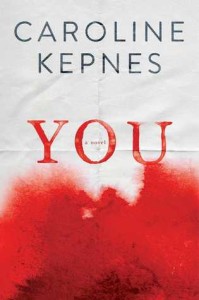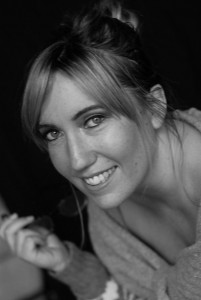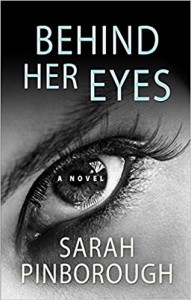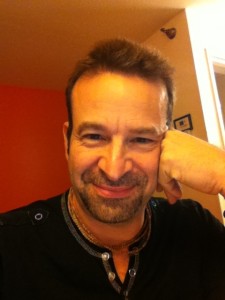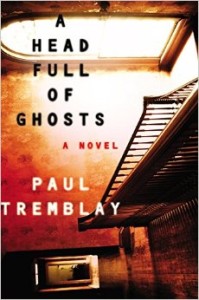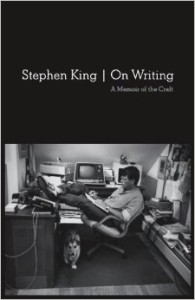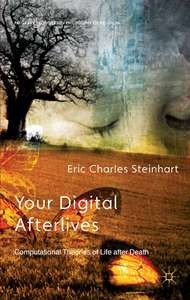 Philosopher Eric Steinhart at William Paterson University has published widely in the areas of metaphysics and philosophy of religion. Among his fascinating contributions is the attention he’s paid to how our digital technologies have provided new and more naturalistic ways of exploring religious topics. “Digitalism,” as Steinhart explains, “is a philosophical strategy that uses these new computational ways of thinking to develop naturalistic but meaningful approaches to religious problems involving minds, souls, life after death, and the divine.”[*] He’s examined the implications of digitalism for life after death in a variety of papers over the past several years, but his most systematic exploration is found in is book Your Digital Afterlives: Computational Theories of Life after Death (Palgrave Macmillan, 2014).
Philosopher Eric Steinhart at William Paterson University has published widely in the areas of metaphysics and philosophy of religion. Among his fascinating contributions is the attention he’s paid to how our digital technologies have provided new and more naturalistic ways of exploring religious topics. “Digitalism,” as Steinhart explains, “is a philosophical strategy that uses these new computational ways of thinking to develop naturalistic but meaningful approaches to religious problems involving minds, souls, life after death, and the divine.”[*] He’s examined the implications of digitalism for life after death in a variety of papers over the past several years, but his most systematic exploration is found in is book Your Digital Afterlives: Computational Theories of Life after Death (Palgrave Macmillan, 2014).
Traditional philosophical and empirical approaches to life after death are subject to a variety of objections. I’ve discussed some of the more refractory conceptual problems in my own book on life after death. Other problems include substantialist views of the self, mind-body dualism, and immaterialist conceptions of the self. These assumptions have unfortunately constrained discourse on life after death and stalemated dialogue. Steinhart provides an alternative afterlife model which is both physicalist in nature and compatible with visions of the afterlife preserved in the rich heritage of the spiritual traditions of the world – for example, rebirth in Buddhism and bodily resurrection in the western Abrahamic traditions.
In my conversation with Professor Steinhart below, he discusses the limits and defects of traditional approaches to life after death, including the flawed paranormal scaffolding of many empirical approaches to life after death. He outlines the contrasting digitalist view of life after death and how it can make sense of traditional religious ideas like reincarnation and resurrection.
Conversation with Eric Steinhart on Life after Death
Sudduth: Eric, I was hoping we could begin with you sharing a bit about your academic background and the genesis and evolution of your interest in the topic of life after death.
Steinhart: I grew up in a hard-core evangelical Christian household. I was very religious, very devout. And many of my male relatives were ministers. So I read the Bible very carefully. I had trouble with the soul – what was it? Why wasn’t it discussed in the Bible? I was fascinated with the resurrection of the body. Eventually, of course, I learned that mind-body dualism is mainly a Greek idea, imposed on a much more materialistic Biblical conception of resurrection. My fascination with resurrection really drove me to think of human persons as entirely physical human animals. I rejected mind-body dualism when I was a teenager. After college, and after I left Christianity, I was a computer scientist for nearly a decade. One day I picked up Hans Moravec’s book “Mind Children”, and I was struck by the similarities of his ideas to my earlier Biblical ideas about resurrection. He introduced me to many of the more religious aspects of computer science.
Digital Afterlives
Sudduth: Lots of people tend to presume that if they’re going to survive death or have some kind of life after death, they must be an immaterial being or at least a being whose consciousness has the capacity to continue without any material substrate. In other words, people think that given materialist assumptions, if the brain dies, then it’s unlikely that the mind will survive. How does this view overlook other possibilities?
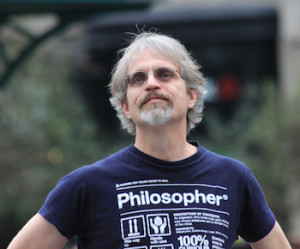 Steinhart: When it comes to life after death, so many people are caught up in Cartesian mind-body dualism. So they overlook other options. They forget that material things like brains and bodies have forms. Material particles are arranged in certain ways to make brains and bodies, and the arrangement carries information. The form or structure of the body encodes information. So the main alternative to mind-body dualism is based on information. Since it’s based on information, it’s a computational view of human animals. We’re purely material things, but our materiality encodes a form. This form is analogous to a computer program. Our bodies are therefore like biological computing machines which run person-programs. Our programs are abstract objects. They are like mathematical objects, such as numbers, or functions from numbers to numbers. Since this view is inspired by digital computing, it can be referred to as digitalism.
Steinhart: When it comes to life after death, so many people are caught up in Cartesian mind-body dualism. So they overlook other options. They forget that material things like brains and bodies have forms. Material particles are arranged in certain ways to make brains and bodies, and the arrangement carries information. The form or structure of the body encodes information. So the main alternative to mind-body dualism is based on information. Since it’s based on information, it’s a computational view of human animals. We’re purely material things, but our materiality encodes a form. This form is analogous to a computer program. Our bodies are therefore like biological computing machines which run person-programs. Our programs are abstract objects. They are like mathematical objects, such as numbers, or functions from numbers to numbers. Since this view is inspired by digital computing, it can be referred to as digitalism.
Following Plato, our person-programs exist eternally. When you are alive, your person-program is instantiated by your body, which runs that program. When you die, your person-program ceases to be run. But your person-program can be run again, later, by some new body. On this view, you don’t survive death; nobody survives death. You can’t live through death. But you can live again after you die. This sort of view is found in the old Stoic doctrine of the eternal return of the same: on the next cosmic cycle, your person-program will be run again. The Stoics thought your old person-program would run again in exactly the same way, thus exactly reproducing your life. But that’s not necessary: on the next cosmic cycle, your circumstances can vary, so that your person-program runs differently, and your next life differs from your previous life. This idea about person-programs running again after death seems to be a good interpretation of early Christian ideas about the resurrection of the body. The early Christian doctrines about resurrection were materialistic. Nobody survives death. But God knows the form of your body – God knows your person-program. So, when you are resurrected, God just makes a new biocomputer that runs your person-program again. Resurrection is recreation. This also seems to be a good way to understand early Theravadic Buddhist ideas about rebirth.
Sudduth: Somewhat related to the prior question, it’s fairly common for people who are contemplating a life after death to conceptualize life after death as the persistence or continuation of an individual self, some notion of personal survival. Some earlier philosophers, C.D. Broad and H.H. Price for example, argued that we might also suppose that it’s only some aspect of our psychological profile that will continue after death, even if it falls short of being a self or at least the same self that ceased to exist at death. Could you say a bit more about this latter possibility?
Steinhart: Digitalism says that you won’t survive death. Of course, some parts of you can survive death. You might be preserved as a mummy. Or parts of your body might be preserved like the relics of the saints. Your bones and skull could persist in a crypt. Or your DNA might be taken from your corpse and used to make a clone. That clone would carry lots of information about you. But it wouldn’t carry your epigenetic information or the information encoded in the interconnections between your nerve cells. It would be a partial version of you. But now we leave lots of data about ourselves behind on our personal computers, on social media websites. So an artificially intelligent deep learning algorithm could read your Facebook page, all your emails, your cell phone text messages, and all the data on your personal computer, and it could use all that data to build an approximation to your mind. It would be a partial version of you. This would be a crude replica. But these replicas can be made more accurate.
The limit of the series of ever better approximations is a replica that exactly duplicates all your information. It’s far more than mere psychology. Human animals are far more than minds. The mind is just the part of the body that computes; not all of the body computes. (Of course, parts of the body that don’t compute can be simulated by computers.) So to be human is to be more than merely psychological. If there were purely psychological entities, they wouldn’t be human. An exact replica of you is functionally equivalent to your whole body. It is functionally indiscernible from your body. Of course, it’s a just a copy. A copy is never identical with its original. Early theories of the resurrection of the body in Judaism and Christianity were replica theories. They involved the reassembly of the atoms in your body to make a replica of your body.
Digitalism implies that, after you die, something will exist which is functionally equivalent to your body. Your person-program will run again on some new machine. It will be a new human animal, realized, perhaps, in very new physics. But it will be realized in an environment which is functionally very similar to your present environment. This is just a consequence of the evolution of complexity: evolution produces sequences of patterns. Old patterns get recycled into new patterns. Simpler patterns evolve into more complex versions of themselves. And this happens at every scale, from quarks to universes. Your person-program, which is just the abstract functionality of your body, is just another pattern. It is caught up in the evolutionary logic of pattern production.
Mind-Body Dualism and Parapsychology
Sudduth: Lots of parapsychologists oppose or are at least highly critical of materialist philosophies of mind, or even the idea that consciousness depends on a functioning brain (or some sort of material substrate). One of the motivations here is the very deeply entrenched belief that materialism or mind-brain dependency can’t account for evidence allegedly suggestive of psychic functioning, be it extra-sensory perception or psychokinesis. In fact, some parapsychologists think the evidence for psychic functioning is evidence against materialism or mind-brain dependency. You have any thoughts on this?
Steinhart: I think the motivation behind parapsychology is terror management (in the sense of terror management theory). Death evokes terror; to reduce that terror, some people turn to occult theories of persons. Mind-body dualism is an occult theory of persons. Parapsychology is part of the occult theory of persons. I regard parapsychology as a pseudo-science. Like other pseudo-sciences, it doesn’t have any theory of its own assertions. Its claims about mind aren’t even false – they’re meaningless. For instance, how does extra-sensory perception (ESP) work? Since it has to involve a flow of information, it falls under information theory. Some channel exists through which information flows at some rate. Some number of bits are transmitted and received. So a theory of how ESP works will involve channels and bits. It will also involve concepts like entropy and mutual entropy. Sometimes you find parapsychologists using terms from information theory. But it’s always vague. Here’s what you never find: a system of equations. Dualists, and parapsychologists, never formulate mathematically precise theories of immaterial minds or of psychic functioning.
For well over two thousand years, dualists have been offering their occult theories of persons. And what do they have to show for it? Nothing. Dualists have produced no useful results at all about immaterial minds. At most they can do some very restricted kinds of introspective psychology. But introspective psychology is almost entirely worthless. There are no technologies based on psychic functioning. Dualism hasn’t led to treatments for mental illnesses. Dualism is a purely negative theory of what it means to be human. It is a way of perverting the meaning of human being. Frightened by death, dualists turn away from the body. They posit a negative image of the body, that is, an immaterial mind. This mind is precious to them. The concept of the immaterial mind is a fetish. By means of ritual inscriptions, the immaterial mind is given an aura and saturated with mana. It has to be shrouded in mystery. You can’t look at it or touch it. It is sacred, and its sacredness needs to be protected from scientific examination, which would make it profane.
The immaterial mind is a shadow-person. It really is a ghost, meaning that it is a purely social construct produced and sustained by fear. If you start to challenge dualists, or those who believe in parapsychology, what you’ll quickly discover is that they panic. They become highly aroused and extremely defensive. They start to repeat the same statements over and over again. They talk about quantum mechanics, or the hard problem of consciousness, or qualia, and so on. But they don’t understand quantum mechanics. Or they don’t understand the philosophy. They repeat themselves without explaining anything. They are not actually engaging in the rational defense of their ideas: they’re chanting. They’re repeating protective spells. They use concepts from the sciences and philosophy like magic words. The words have no meanings; they cannot be logically analyzed; rather, the words are sounds used in incantations. Dualism really does belong with the occult, in the sense of magic. Anthropologists have studied magic. And that anthropological study applies to dualism.
Still, it’s hard for me to understand the hostility to materialist theories of mind. Materialism has produced detailed and comprehensive descriptions of our minds; it has helped us heal mental illnesses. But even more: materialism is beautiful. Just take a look at molecular psychology. Look at molecules like mirtazapine or psilocybin. Look at how they bind to receptors. It’s gorgeous! All that detail, all that complexity, all that computation! To turn away from materialism is to turn away from mentality. Dualists hate the mind. They hate its reality and want to replace that reality with an empty fiction. The really shocking thing is just how empty that fiction really is. Dualists have nothing to say about minds. I think dualists actually hate mentality. They despise the mind.
On Paranormal Phenomena
Sudduth: As you know, in my 2016 book on survival I offered a critique of a particular empirical approach to survival, the attempt to argue in favor of survival on the basis of certain ostensibly paranormal phenomena. For example, I discuss verifiable claims to past-life memories and closely-related phenomena seemingly suggestive of reincarnation. I also examine mental and trance mediumship, where mediums – who profess to communicate with the dead – have detailed information about the deceased and are sometimes able to convey this information through convincing life-like personations of the deceased.
Traditionally, the arguments for survival based on the data collected from these phenomena tend to rest on substance dualist commitments. At any rate, it’s widely assumed that if these data are evidence for survival or life after death, then physicalism must be false.
Now, to the extent that the data concern the persistence of the psychological profile of some formerly living person, or some significant aspect of their psychology, it’s not obvious to me that a physicalist model such as digitalism can’t accommodate these data in principle. Your thoughts on this?
Steinhart: Digitalism doesn’t require computers to be material. The definition of a Turing machine, for example, doesn’t involve any matter. Logic gates, and networks of logic gates, can be as immaterial as you please. Likewise connectionist models of massively parallel distributed processing systems can be immaterial. You can develop precise mathematical theories of immaterial information processing machines of any degree of complexity you like. And you could go on to define ways those machines would interact with materially realized computers. Of course, this would involve writing out systems of equations. It would involve describing lawful interactions among different kinds of systems. Digitalism does not rule out immaterial minds. But it requires that those minds be described in precise mathematical terms. It requires lawful regularities. On the basis of those lawful regularities, you can do science and build technologies.
But this is where the conflict with the paranormal starts. Paranormal phenomena never fall into lawful patterns. They never exhibit lawlike regularities. They never appear in patterns which are reliably reproducible. But that’s what data is. Data is information that you can reliably gather, in reproducible experiments. So there really isn’t any such thing as data in parapsychology or the study of the paranormal. Paranormal phenomena are always noise, never signal. They can’t be reliably reproduced. They can’t be used to make any technologies. There are no laws which describe those phenomena or how they occur.
For a digitalist, sure, there could be mediums. When you die, your person-program could be run by an immaterial computing machine. It would be functionally isomorphic to your body. It would be a kind of immaterial animal. And there could be information channels linking these immaterial animals to material humans. But all of that would be lawlike. There would be equations which describe the channels. There would be scientifically describable structures in the brains of mediums, structures tuned to receive information from immaterial computers. There would be textbooks filled with equations. You could train to be a medium. Mediums would be able to communicate with the dead reliably, on command, in precisely defined ways. None of this would be mysterious or controversial. It would be as reliable as cell phones
So why does the so-called data about the paranormal fail to fall into lawful patterns? Why is it always noise and never signal? The answer comes, again, from terror management theory. They body falls under lawful regularities; it is a structure which exhibits mathematical patterning. But the immaterial minds of the dualists, the occultists, and the parapsychologists are fetish objects created as magical protections against the fear of death. They are purely imaginary objects which cannot exist within any lawful structures at all. They cannot exist within any patterns, because the patterns would subject them to real constraints. They would stop being sacred, and would become profane. Microsoft would start to produce software that would let your computer talk to the dead. There would be industries devoted to it. Money would change hands. Death would cease to be shrouded in its mysterious aura; its mana would be gone. So all paranormal phenomena have to be relegated to the noise. They have to inhabit the shadow-land of uncertainty. They have to be irregularities. Magic requires fear; fear requires uncertainty; and uncertainty is noise.
Digitalism and Testability
Sudduth: Beyond their traditional entanglement in the rejection of physicalism, a more serious problem – indeed a core problem – I find with the empirical arguments for survival from psychical research is that a simple supposition of souls or consciousness surviving death wouldn’t lead us to expect the relevant data, even most generally described. So, to accommodate the data, we must bulk up the idea of survival with various auxiliary assumptions – for example, the assumption that at least some survivors would retain a significant amount of their memories, interests, desires, and other personality traits characteristic of their antemortem existence, as well as possess the capacity to interact with the physical world. The problem is that there are many ways the life after death narrative could go. While some of these narratives would accommodate the data, most of them would not. There seems to be no (non-circular) justification for favoring the narrow band of requisite auxiliaries over the many alternatives.
Now I have to wonder whether this problem of auxiliary assumption selection isn’t less of a problem given digitalism. And here it seems like there are two salient points.
First, generally it seems that it’s going to rest on assumptions that are in principle testable, for the production of mental states by brain processes (or some similar physical process) seems testable in ways that the purported relationship between mental states and an immaterial soul isn’t.
Second, if we are material machines running abstract person programs, and psychological continuity is fundamentally informational continuity, it would seem that we could (at least some point) say what kind of patterns produce and sustain particular aspects of our psychology. This would lead us to expect certain continuities in psychological profile given the replication of the organizational material structures.
Steinhart: Digitalism aims to be precise, and to be precise in scientific ways. It is developed out of the sciences of information, computation, and complexity. So of course digitalists are at least functionalists about minds: if you make an artificial machine that is functionally equivalent to a brain, it will do what the brain does. Of course, you’ve got to embed that system in something that is functionally equivalent to a body, such as an artificial robot, or a virtual reality world. You’ve got to replicate the physicality of the flesh, and the physicality of its environment. But the claims of digitalism are, as you say, empirically testable. We’re testing them all the time as we build digital technologies, and as we study the brain. And so far, all the tests are being passed, every day. We can and do make artificial replicas of neural networks. And those replicas perform the predicted functions. We build artificial vision systems, artificial pattern recognition systems, all based on the study of the brain. Unlike dualism, digitalism produces useful results.
Digitalism and Reincarnation
Sudduth: In your paper “Digital Afterlives,” you discuss “digital reincarnation.” Can you explain the basic features of this alternative model of reincarnation and how it differs from traditional reincarnation views?
Steinhart: Reincarnation theories usually say the same soul gets repeatedly embodied in different bodies. It seems to require a soul-body or mind-body dualism. Often these dualisms are substance dualisms, so that the soul is made of some kind of immaterial stuff. There’s no need to be a substance dualist in order to talk about reincarnation. If you copy data from one computer to another, that data gets reincarnated on the new computer. So if you copy the structure of your brain or body into some software body in some virtual reality like a video game, or into software running on some robot, that’s digital reincarnation. There’s no evidence that people get reincarnated on this earth, and it doesn’t even make much sense to talk about a human being reincarnated as an non-human animal or vice versa. But some traditional Eastern theories of reincarnation talk about reincarnation across universes. If you’ve got a multiverse, this becomes possible. So the soul is the form of the body, and reincarnation is just reinstantiation.
It’s interesting to think of ways karma might be involved in digital reincarnation. It might work in cases of multiverse reincarnation, where your body-pattern (that is, your soul) gets reinstantiated in some other body. Karma is often thought of as punitive or retributive: an eye for an eye. But it doesn’t have to be that way. The spiritist followers of Kardec, for instance, advocated a progressive sort of karma, in which you are progressively learning moral lessons. This isn’t retributive punishment, rather, it’s reformation or rehabilitation. Karma is corrective rather than punitive. There are lots of interesting ethical ideas here.
Recommendations for Further Reading
Sudduth: What three papers or books – your own or others – would you recommend to people who want to explore digitalism and life after death but who don’t have a very deep background in philosophy or science?
Steinhart: Hans Moravec, Mind Children; Eric Steinhart, Your Digital Afterlives; John Hick, Death and Eternal Life
Sudduth: Thanks for the conversation, Eric. As Jimi Hendrix once said, “If I don’t meet you no more in this world, then I’ll meet you in the next one. Don’t be late.”
[*] Steinhart, Your Digital Afterlives (Palgrave Macmillan, 2014), xii.
 Follow
Follow

